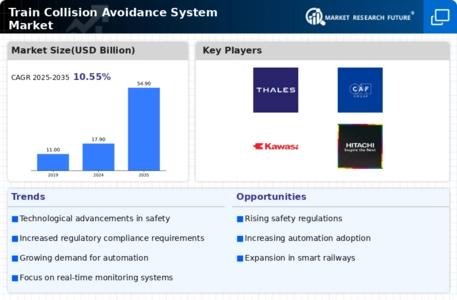Government Initiatives
Government initiatives aimed at enhancing rail safety are significantly influencing the Train Collision Avoidance System Market. Various countries are implementing stringent regulations and providing financial incentives to promote the adoption of advanced safety technologies. For instance, funding programs for upgrading existing rail infrastructure and implementing collision avoidance systems are becoming more prevalent. In 2025, it is estimated that government investments in rail safety technologies will exceed several billion dollars, reflecting a commitment to reducing accidents and improving overall safety. These initiatives not only encourage manufacturers to innovate but also create a favorable environment for the deployment of collision avoidance systems. As a result, the Train Collision Avoidance System Market is likely to experience accelerated growth due to these supportive governmental policies.
Increased Rail Traffic
The rise in rail traffic is a crucial driver for the Train Collision Avoidance System Market. As urbanization continues to expand, the demand for efficient and safe rail transport is increasing. In 2025, rail networks are expected to handle a higher volume of passengers and freight, necessitating the implementation of advanced safety measures. The increase in train frequency and density raises the risk of collisions, making collision avoidance systems essential for maintaining safety standards. Consequently, rail operators are investing in these systems to mitigate risks associated with higher traffic levels. This trend indicates that the Train Collision Avoidance System Market is poised for growth, as stakeholders prioritize safety in the face of increasing operational demands.
Technological Integration
The integration of advanced technologies into the Train Collision Avoidance System Market is a primary driver. Innovations such as artificial intelligence, machine learning, and real-time data analytics are enhancing the capabilities of collision avoidance systems. These technologies enable predictive maintenance and improve situational awareness, thereby reducing the likelihood of accidents. As of 2025, the market is projected to grow at a compound annual growth rate of approximately 8.5%, driven by the increasing adoption of these technologies. The ability to process vast amounts of data in real-time allows for quicker decision-making, which is crucial in preventing collisions. Consequently, the Train Collision Avoidance System Market is witnessing a shift towards more intelligent and automated systems, which could potentially redefine safety standards in rail transport.
Competitive Market Dynamics
The competitive dynamics within the Train Collision Avoidance System Market are fostering innovation and driving growth. As numerous players enter the market, there is an increasing emphasis on developing cutting-edge technologies to gain a competitive edge. Companies are investing heavily in research and development to create more effective and reliable collision avoidance systems. This competitive landscape is likely to lead to advancements in system capabilities, such as improved sensor technologies and enhanced communication systems. By 2025, the market is expected to witness a surge in new entrants and innovative solutions, which could reshape the industry. The drive for differentiation among competitors is propelling the Train Collision Avoidance System Market towards a future characterized by enhanced safety and efficiency.
Public Awareness and Safety Concerns
Growing public awareness regarding safety in rail transport is driving the Train Collision Avoidance System Market. As incidents of rail accidents receive heightened media coverage, public demand for safer travel options is increasing. This awareness is prompting rail operators to invest in advanced collision avoidance technologies to enhance safety measures. In 2025, consumer expectations for safety are likely to be at an all-time high, influencing operators to adopt innovative solutions. The pressure from the public and advocacy groups is compelling stakeholders to prioritize the implementation of collision avoidance systems. As a result, the Train Collision Avoidance System Market is experiencing a shift towards more robust safety protocols, reflecting a broader societal commitment to reducing accidents and ensuring passenger safety.


















Leave a Comment